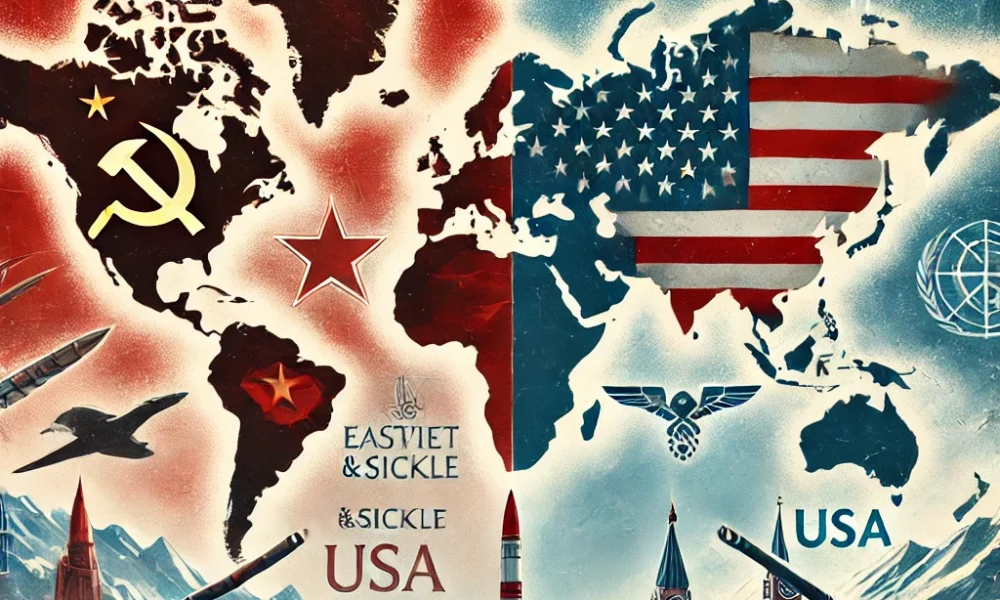The Cold War, a prolonged period of geopolitical tension between the United States and the Soviet Union, shaped much of the 20th century.
Lasting from the end of World War II in 1945 until the dissolution of the Soviet Union in 1991, the Cold War was characterized by ideological, political, and military rivalry.
While the conflict never escalated into a direct large-scale war between the superpowers, its impact was felt worldwide through proxy wars, political interventions, and the ever-present threat of nuclear annihilation.
Table of Contents
Origins of the Cold War
The seeds of the Cold War were sown during World War II, despite the temporary alliance between the U.S., the Soviet Union, and other Allied powers to defeat Nazi Germany.
Deep ideological differences between the capitalist democracy of the United States and the communist state of the Soviet Union created an underlying mistrust.
The division of Europe after the war further exacerbated tensions.
The Yalta and Potsdam Conferences in 1945 established spheres of influence, with Eastern Europe falling under Soviet control.
The U.S. perceived this as a threat to democracy and freedom, while the Soviets viewed American actions, such as the Marshall Plan, as attempts to undermine their influence.
Key Events and Phases of the Cold War
1. The Iron Curtain and the Early Years (1945-1950):
- British Prime Minister Winston Churchill famously declared in 1946 that an “Iron Curtain” had descended across Europe, symbolizing the division between the capitalist West and the communist East.
- The U.S. adopted the Truman Doctrine in 1947, pledging to support nations threatened by communism, followed by the Marshall Plan, which provided economic aid to rebuild Western Europe and counter Soviet influence.
2. The Arms Race and Nuclear Brinkmanship (1950s):
- Both superpowers engaged in a nuclear arms race, stockpiling weapons and testing increasingly powerful bombs.
- The establishment of NATO (North Atlantic Treaty Organization) in 1949 and the Warsaw Pact in 1955 solidified military alliances on both sides.
3. The Space Race (1957-1970s):
- The launch of the Soviet satellite Sputnik in 1957 marked the beginning of the space race, leading to significant technological advancements.
- The U.S. responded with the creation of NASA and the Apollo program, culminating in the moon landing in 1969.
4. Proxy Wars and Global Influence (1950s-1980s):
- The Cold War was fought indirectly through proxy wars in regions such as Korea, Vietnam, and Afghanistan.
- These conflicts often resulted in significant casualties and political instability in the affected countries.
- The Cuban Missile Crisis in 1962 brought the world to the brink of nuclear war, underscoring the dangers of the Cold War rivalry.
5. Détente and Renewed Tensions (1970s-1980s):
- The 1970s saw a period of détente, or relaxation of tensions, marked by arms control agreements like the Strategic Arms Limitation Talks (SALT).
- However, the Soviet invasion of Afghanistan in 1979 and the aggressive rhetoric of U.S. President Ronald Reagan in the 1980s reignited hostilities.
Tom Jones: The Soulful Voice That Defined an Era
The End of the Cold War
The Cold War began to wind down in the late 1980s due to several factors:
1. Economic Struggles:
The Soviet Union faced severe economic difficulties, making it challenging to sustain the arms race and maintain control over its satellite states.
2. Reform Movements:
Soviet leader Mikhail Gorbachev introduced reforms such as glasnost (openness) and perestroika (restructuring), which aimed to modernize the Soviet economy and promote transparency.
3. Collapse of Eastern European Regimes:
Pro-democracy movements in Eastern Europe, supported by the West, led to the fall of communist governments in countries like Poland, Hungary, and East Germany.
The fall of the Berlin Wall in 1989 became a powerful symbol of the Cold War’s end.
4. Dissolution of the Soviet Union:
In 1991, the Soviet Union officially dissolved, marking the end of the Cold War.
Impact of the Cold War
The Cold War had far-reaching consequences:
1. Political:
The division of the world into two ideological camps influenced international relations and created long-lasting alliances.
2. Economic:
The arms race and space race spurred technological innovation but also placed immense financial strain on the superpowers.
3. Social:
Propaganda, espionage, and fear of nuclear war deeply affected societies on both sides.
4. Cultural:
The Cold War left a lasting legacy in literature, film, and art, reflecting the fears and aspirations of the era.
Conclusion
The Cold War was a defining period in modern history, shaping global politics, economics, and culture.
Its legacy continues to influence international relations, with lingering tensions and alliances rooted in the geopolitical landscape it created.
By understanding the Cold War, we gain insight into the complexities of power, ideology, and human resilience in the face of conflict.
FAQ’s On Cold War Summary
1. What was the Cold War short summary?
The Cold War (1947–1991) was a period of intense rivalry between the United States and the Soviet Union, marked by ideological, political, and military competition without direct large-scale conflict.
It included events like the arms race, the space race, and proxy wars in regions like Korea and Vietnam.
The Cold War ended with the collapse of the Soviet Union in 1991, signifying the triumph of capitalism over communism.
2. Why is it called a cold war?
It is called a “Cold War” because the United States and the Soviet Union never engaged in direct, large-scale military conflict (“hot war”), instead competing through proxy wars, ideological battles, and strategic rivalries
3. What does USSR stand for?
Union of Soviet Socialist Republics
4. Who ended the Cold War?
The Cold War ended through the efforts of several key leaders, including U.S. President Ronald Reagan and Soviet leader Mikhail Gorbachev, whose reforms and diplomatic negotiations helped reduce tensions.
The collapse of the Soviet Union in 1991 officially marked the Cold War’s end.
5. Does Cold War still exist?
The Cold War officially ended with the dissolution of the Soviet Union in 1991, but remnants of its tensions persist in modern geopolitics.
Rivalries between major powers, such as the United States, Russia, and China, sometimes evoke comparisons to the Cold War, though these situations differ in scope and nature from the original Cold War.
6. Who actually won the Cold War?
The United States and its allies are often considered the “winners” of the Cold War, as the Soviet Union collapsed in 1991, leading to the end of its communist regime and the dissolution of its superpower status.
This outcome marked the dominance of capitalism and democracy over communism in the global order.
However, some argue it was not a clear victory but a shift in global dynamics, with significant costs and lasting consequences for both sides.
7. How many years is Cold War?
The Cold War lasted for 44 years, from 1947, when tensions between the United States and the Soviet Union escalated after World War II, to 1991, when the Soviet Union dissolved.


